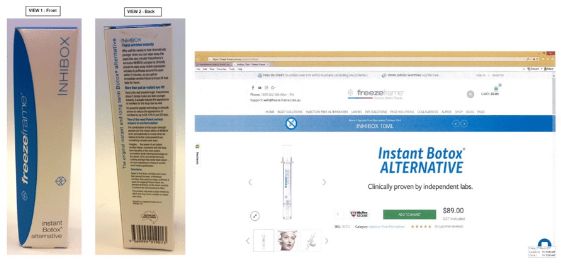In Self Care IP Holdings Pty Ltd v Allergan Australia Pty Ltd [2023] HCA 8, Allergan failed in its attempt to prevent use of the phrase "instant Botox® alternative", and use of the trade mark PROTOX.
What was the Issue?
- Self Care used the phrase "instant Botox®
alternative" on its packaging and its website as a trade
mark (examples below)

- Self Care also used the trade mark PROTOX (example below)

- Allergan objected to the unauthorised use of its BOTOX trade mark and to use of the PROTOX trade mark
What did Allergan claim?
- That use of "instant Botox® alternative" infringed its BOTOX trade mark registrations.
- That BOTOX and PROTOX are deceptively similar, meaning that use of PROTOX infringed its BOTOX trade mark registrations.
- That use of "instant Botox® alternative" amounted to a misleading representation of generally equivalent effects to BOTOX, so as to contravene Australian Consumer Law. In particular, argument centred around whether that statement would be understood as a representation that the wrinkle reducing effects of the product would last for a period equivalent to that provided by a Botox injection.
Decision in 'Instant' Infringement
- The use of "instant Botox® alternative" did not infringe the BOTOX trade mark registrations because BOTOX was not being used 'as a trade mark' in that reference.
Factors Leading to This Conclusion
- In assessing whether there is use as a trade mark "the correct approach is to ask whether the sign used indicates origin of goods in the user of the sign". In other words, the question is not so much whether they might be seen as a reference to some or another business, but whether they are being used to identify the products of the user. In this case BOTOX was not being used in that way because:
- "Of particular significance" was the fact that the expression appeared alongside two clear badges of origin used by Self Care, namely FREEZEFRAME and INHIBOX;
- The representations of FREEZEFRAME and INHIBOX were distinctive and stylised and apt be perceived as brands;
- The use of "instant Botox® alternative" was inconsistent in size, font and presentation on packaging and elsewhere.
- In these circumstance, the use of BOTOX was not viewed as use to identify the products of Self Care
Decision in PROTOX Infringement
- The words PROTOX and BOTOX are sufficiently different that even allowing for imperfect recollection, they would not be confused.
- The Full Federal Court erred in taking into account reputation in the BOTOX trade mark when making its assessment. Reputation is not a consideration when determining whether there is a likelihood of confusion between two trade marks.
- Surrounding circumstances can be taken into account, but the references to "Botox" in relation to PROTOX products did not lead to a likelihood of confusion having regard to the nature of the representations, disclaimer of association, consistent use in proximity to FREEZEFRAME and no evidence of actual confusion.
Decision on Misrepresentation
- The Full Federal Court made mistaken assumptions about the meaning of "instant Botox® alternative" and the High Court concluded:
it is difficult to conceive why the reasonable consumer in the target market would think that a topically self-applied cream obtained from the pharmacy at a relatively low cost and worn in the course of the usual activities of life (including bathing and exercise) would have the same period of efficacy after treatment as an injectable anti-wrinkle treatment that is only available to be administered by healthcare professionals at a higher cost
Consequences
- The decision has important consequences for the owners of well-known brand names, as it will likely increase the difficulties faced by owners that wish to deter other traders from referencing, and arguably taking some advantage from, their trade marks;
- The decision will increase the difficulties for trade mark owners trying to establish trade mark infringement by raising the bar in respect of what amounts to "use as a trade mark", which is a prerequisite to a finding of infringement;
- The decision establishes that reputation is not a consideration when assessing deceptive similarity. This worked against the well-known brand in the High Court's decision, but it is also potentially helpful to the owners of well-known brands. There has been a growing tendency to find that there is a lower likelihood of deceptive similarity (i.e. confusion) between a well-known brand and another trade mark. This has been based on an assumption that the well-known brand, due to its reputation, will be more clearly recalled and is therefore less likely to be confused with another trade mark. However, this reasoning is no longer relevant because reputation should not be taken into account.
The content of this article is intended to provide a general guide to the subject matter. Specialist advice should be sought about your specific circumstances.


